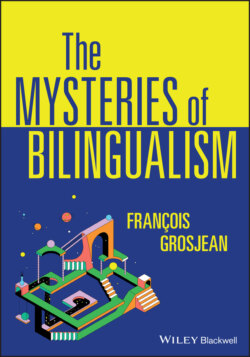Читать книгу The Mysteries of Bilingualism - Francois Grosjean - Страница 9
Definitions and Their Evolution What Lay People Say
ОглавлениеWhen I wrote my first book on bilingualism some 40 years ago (Grosjean 1982), I conducted a short survey in order to uncover the lay person’s understanding of the term “bilingual.” I asked a number of monolingual college students to answer this question: “If someone told you that X was bilingual in English and French, what would you understand by that?” The most frequent response I found (36% of the answers) was that X speaks both languages fluently. This was followed by X speaks English and French (21%), and by X understands and speaks English and French (18%)? Note that the summed percentages of the two latter answers, which basically say the same thing, add up to 39%. The same question asked of a group of bilinguals gave very similar results: X speaks the two languages fluently (31%), and speaks the two languages (46%). Thus, just speaking both languages (which includes both production and perception), gets a bit less than half of the responses in the two groups, and speaking both languages fluently is only just behind, with 36% and 31% respectively. This shows the importance of fluency1 in the participants’ mind, be they monolingual or bilingual.
Both groups were then asked to rate the importance of a number of factors that had been mentioned in definitions of bilingualism, such as being fluent in two languages, having both speaking and writing fluency in them, using two languages regularly, etc. The scale used went from 1 “not important” to 5 “very important.” The monolinguals gave a mean rating of 4.7 for being fluent in two languages, and the bilinguals gave it a rating of 4.4. Speaking and writing fluency in two languages was given a rating of 4.0 by the monolinguals and 3.6 by bilinguals, and equal fluency in two languages was rated 3.7 and 4.1 by the two groups, respectively. Thus, once again both monolinguals and bilinguals felt that fluency in two languages is an important factor in describing the bilingual person.
It is interesting to note that monolinguals differed most from bilinguals on the question of language use, a factor that we will evoke often in this chapter. For monolinguals, the factor labeled “regular use of two languages” received a mean rating of 3 (that is, it was not considered a very important factor), but the bilinguals gave it a mean rating of 4.1, just below “fluency in two languages” (4.4). So here, on language use, monolinguals and bilinguals diverged a bit, probably because bilinguals are more aware of the communicative aspect of being bilingual, that is, using two languages irrespective of your fluency in them.
Where do things stand now? Two surveys were conducted this century, one by Zubrzycki (2019) and one some 13 years before by Sia and Dewaele (2006). Zubrzycki wanted to replicate the Sia and Dewaele study, which asked speakers of at least two languages: “Are you bilingual?” According to the answer they gave, they were placed in the “bilingual” or “non-bilingual” group, and it was shown, among other things, that the self-assessment of second language (L2) proficiency was higher in the “bilingual” group than in the “non-bilingual” group. This was true overall, but also for the four basic skills: Speaking, listening, reading and writing. Zubrzycki conducted the same kind of study but with a slightly different question, “Do you consider yourself bilingual?” He found practically identical percentages to Sia and Dewaele for those who labeled themselves as bilingual or not, and very similar assessment results.
Interestingly, Zubrzycki (2019) added an open-ended question to his study: “How would you define the term bilingual?” It was very similar to Grosjean’s (1982) first question, and it is worth examining the answers more closely. As concerns those who self defined as “non-bilinguals,” nearly 80% formulated a restrictive definition of bilingualism. Zubrzycki does not give percentages but he reports that the main criterion put forward was equal proficiency in two languages, implying thereby a native-like command of the L2 with no traces of one language when using the other and, in particular, no traces of a foreign accent. Other elements which appeared in the definitions were items such as “native level,” “native speaker,” “mother tongue,” and “native language.” And some also said that the bilingual is required to have been raised in a bilingual family or to have had a long-term stay in the L2 environment.
Of those who self defined as “bilinguals,” however, over 70% were less restrictive in their answers. Among the criteria expressed, we find feeling comfortable when using the L2, and reaching a level at which communication becomes natural and effortless. There was also the ability to communicate effectively in all domains of language use and in a wide range of social contexts. Finally, a number of definitions underlined everyday use of two languages.
Thus, over a span of some 40 years, quite similar results have been obtained from lay people, with a slight difference between those who are, or who self define as, bilingual, and the others. Zubrzycki concludes that a monolingual view of bilingualism – the bilingual should be two monolinguals in one person (criticized by Grosjean 1985) – is still deeply entrenched in the lay person’s perception of what it means to be bilingual. Will a similar tendency be found in dictionary definitions? They reflect the meaning of words based on current usage but they are also the work of lexicographers many of whom have some linguistic training. We now turn to this.
